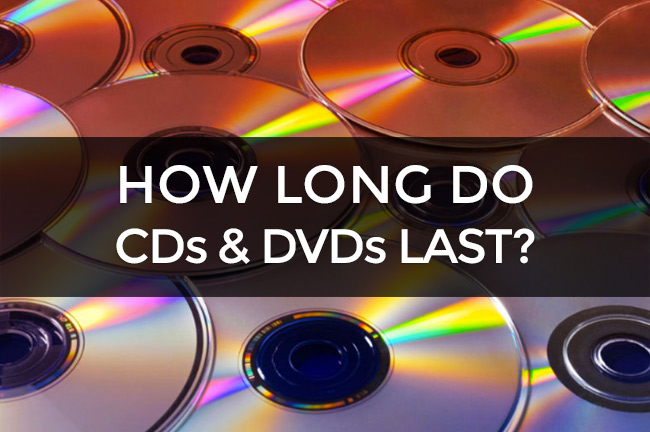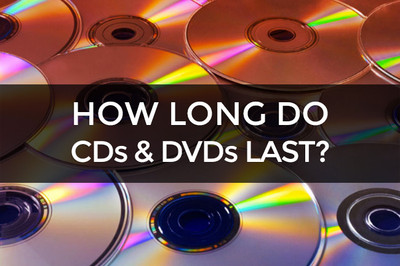How Long Do CDs and DVDs last?
Simi for BargainShopUK on Jan 24th 2017
 CDs and DVDs have existed for years and almost everyone on Earth owns at least one of both. As fun as they are to have as a keepsake, they are known to wear out after a long period of use.
CDs and DVDs have existed for years and almost everyone on Earth owns at least one of both. As fun as they are to have as a keepsake, they are known to wear out after a long period of use.
In this article, we will explain how long CDs and DVDs will last for a long period time and how they should be treated and how to help your collections last.
The Beginnings of the CD and DVD
Let’s go back to the beginning when the CD and DVD mediums were introduced.
The CD-R (then known as the Compact Disc or the CD-ROM) was created in the early 1990’s as a way of replacing the Cassette Tape.
The DVD was introduced in the late 1990’s as a gradual replacement for video cassette tapes. CD and DVDs were created as a way to expand the data life of video and sound.
By 2003, CD-Rs had sold 7,150 million copies while DVD-R sold more than 400 million copies. Both disc types are used as storage devices to archive all different types of files.
Types of CDs and DVDs and what they can be Used For
There are many ways in which CDs and DVDs can be used and first, it is necessary to know what types of CDs and DVDs there are before you go about copying things over to any CD.
- CD-R
- CD-RW
- CD+R
- CD+RW
- DVD-R
- DVD-RW
- DVD+R
- DVD+RW
While there are many types of CDs and DVDs out there, there are also many different uses for them. Here are just a few:
- Precious memories, like family home movies and photos
- Music collections
- Homemade movies
- Storing important documents
Testing the Discs
If you are using CDs and DVDs, there are a couple of fool proof ways to ensure that the data life is good.
- Create a few discs of each format (CD and DVD) and wait 25 years or more to see if they have the correct data still on them
- Get a CD/DVD analyser and have the discs scanned to ensure that they hold the right information
The first point was a little joke. The second point is the more practical one.
Japan produced and wrote the first discs and the data on these discs are in fact still very much in working order.
However, there are others that do not think about how their users store the media on the disc.
CD-Rs were produced in the early 1980’s and are now considered to the predecessor to the double layered DVD+R discs that exist today.
Upon the disc testing being completed, media manufacturers have to ensure that the discs have been tested with the procedures of the International Standards Organisation (ISO) and that are of ISO quality.
The ISO has found that their document and data life can survive between 50 years to that of 200 years. However, it is to be noted that there are differences between the quality media company and the low budget media establishments.
There are different variations of the various manufacturing procedures associated with the media format.
An example of testing a disc would be if you placed a DVD i.e. The Good Dinosauror Inside Out in a DVD drive to see if they are working.
Understanding How Discs Work
While it is not necessary to understand the advanced workings of any form of disc, a user will need to have an understanding of what makes a quality disc that will be able to be read years after we are all gone.
One of the common beliefs that users seem to have are that DVD-Rs are basically another version of the CD-R. This is incorrect though, they are different but they share similarities with each other.
Discs that allow data to be copied onto the medium begin with a piece of polycarbonate substrate that show where the grooves on the disc are moulded while there is a dye layer that is followed by a layer that is reflective. These layers are then followed for a few protective layers.
Arising Problems
When it comes to the quality of media, it is essential that they do not want to lose the information.
There have been claims and beliefs of many consumers as to what is best when keeping the information on tact.
Discs are known as to rot which can be very bad for the disc. Earlier LaserDiscs were known to decay and ruin the information. Newer discs like CDs and DVDs day do not affect the media that is on the format. This is called Delamination and oxidation.
For any person that is reading this article is probably frowning and wondering what the heck Delamination and oxidation are and what they do. Let us explain.
Delamination and oxidation occur on the edge of a disc when the adhesive is not applied properly and cured in the correct way during the process of production. This normally occurs when manufacturers are price oriented, are 2 to 3 generations in age and use manufacturing equipment of the same age. Cheap materials are also utilised.
- When air comes in contact with a reflective layer is what causes Oxidation
- Layers and coating can also be susceptible to a Galvanic reaction
- Impurities can appear on a disc’s coating
The True Culprit
When you purchase a product, you would expect quality. However, if you purchase a product, like a CD or DVD, you might not get the expected 50-100 years of data life like it is believed.
The biggest danger is the longevity of the information that is stored on the discs. If the discs are left in direct sunlight, it can cause damage that can add stress to the disc’s material. It will also cause the disc to warp.
Does and Don’ts when Handling Discs
Do
- When picking up discs handle them around the edges or the hole in the centre
- When writing on the labelled surface of any disc use a non-solvent based felt tip marker
- Clean the disc so that it is clear of dirt and other foreign matter
- Be sure to
- Store discs in cases that are made specifically made for DVDs and CDs and make sure they store book style (upright)
- Whenever discs are not in use, return them to their cases
- Leave discs in their cases to avoid any changes to the environmental
- Remove the plastic wrap from a recordable disc only when the disc is meant to be used
- Store discs in a cool, dark place where the air is clean in which the humidity is low and the temperature is between 4℃ and 20℃
- Check and remove dirt and foreign matter by using a cotton cloth
- Use distilled water to clean discs. Only use rubbing alcohol and diluted dish washing detergent in tough situations. When rinse the liquid off with a lint-free cloth or a photo lens tissue
Don’t
- Do not touch the surface of the disc
- Do not bend the disc in any way
- Do not store discs horizontally over long periods of time
- Do not open recordable discs if they are not ready to be used
- Do not expose discs to heat or humidity of high levels
- Do not expose any recordable CDs or DVDs to UV rays
- Do not write on the readable part of the disc
- Do not use a circular movement when cleaning discs
Conclusion
While not all discs are great to use work, those of us here at BargainShopUK believe that is not wise to cross the quality with low prices. However, they are a reliable medium for irreplaceable data like family photos. We highly recommend that data be backed up on another medium just in case of emergencies. It is also important to consider the quality of the data when it comes to such data.
If you have any questions be sure to contact us through this post or through our regular social media channels.





